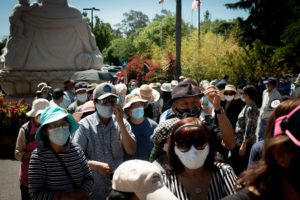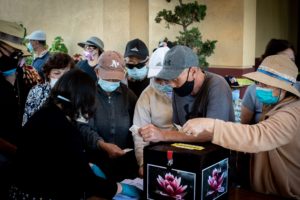James Foster lined up at the Di Lac Temple in San Jose, waiting for a hot meal, fresh groceries and face masks. Foster’s wife lost her job as a therapist during the pandemic and his relative who supported them financially recently died.
“We’re hurting … These folks provide a life-saving service, especially for someone my age,” said Foster, 76.
The Vietnam War veteran considers himself lucky because he has a pension to fall back on, pointing to others who may be less fortunate. With a mortgage to pay, however, making ends meet during the coronavirus outbreak continues to be a challenge.
As the shutdown has left many residents in Santa Clara County and across the Bay Area jobless, people are struggling to feed their families. Religious organizations, nonprofit organizations, schools and government assistance programs have become their lifelines as scores of households seek food assistance for the first time.
“There’s a growing anxiety around food and nutrition,” Santa Clara County Supervisor Dave Cortese said. “You’re seeing more middle-income families, or families that were middle-income, in food lines … It’s heartbreaking. Just a few weeks ago, we had the most robust economy in the world. We had the highest workforce productivity of any metropolitan area in the world just two months ago.”


In April, Second Harvest of Silicon Valley established its fourth warehouse in San Jose to meet the surging demand. Officials say they’ve delivered more than 2 million meals a week last month, a 45 percent spike compared to February. The nonprofit received an average of 1,000 daily calls to its food connection hotline in April, up from about 150 a day before the pandemic. More than 150 National Guard members are distributing food and fielding calls at Second Harvest.
The number of people applying for food stamps in the county have soared, too. The Santa Clara County Social Services Agency received double the number of applications for CalFresh — the state’s food assistance program funded by the federal government. The county received about 8,000 applications in April compared to 4,000 in March, according to Angela Shing, director of the Department of Employment & Benefit Services at Santa Clara County Social Services Agency.
CalFresh is generally available to households earning less than 200 percent of the federal poverty level before taxes, which is a gross monthly income of $4,292 for a household of four. Meanwhile, Shing said applications for the state’s health insurance Medi-Cal and, cash aid and services program CalWorks have remained leveled. She anticipated that applications for Medi-Cal and CalWorks would also increase in the months ahead.
“Right now, food insecurity is the immediate impact for everyone — no matter which socioeconomic class they’re in,” Shing said.
Despite the surge in applications, the agency issues CalFresh benefits at an average of nine days. Homeless or extremely low-income residents usually receive expedited benefits within three days, Shing said.
“If you are in need, come and apply,” Shing said. “My eligibility staff will walk you through what we need.”


Many Bay Area residents seek Second Harvest’s guidance to apply for CalFresh.
“(A single dad) had his child call the hotline because he couldn’t bear to do it,” said Patricia Cervantes, food connection specialist at Second Harvest of Silicon Valley. “You can hear him crying in the background. He couldn’t believe that he can’t feed his kids and he’s having to ask for food.”
But enrolling people in CalFresh remains a challenge.
While older adults prefer to apply for CalFresh in person, the food bank has temporarily canceled in-person appointments because of the pandemic, said Kelly Chew, director of services at Second Harvest of Silicon Valley. They’re often hesitant to share personal information, such as their social security number, to strangers. Others are reluctant to share their struggles.
Still, some applicants find comfort in talking to the operators on the food connection hotline who speak their language, Chew added.
Another barrier lies in people’s longstanding distrust in government. Many of them are fearful of the Trump Administration’s expansion of the public charge rule, according to Cervantes. The rule went into effect in February, penalizing some immigrants who are enrolled in federally-funded public benefit programs, including CalFresh, and reducing their chances of receiving green cards or visas. While the rule doesn’t apply to many, it has stoked fear among their communities.
“They’re afraid of what they hear,” Cervantes said.
Others have missed out on CalFresh, Cervantes said, because they didn’t know they could apply for more than one public assistance program. Those who do apply are faced with a labyrinth of rules and paperwork, a challenge for older adults and people with disabilities.


Potential solutions
California Sen. Scott Wiener (D-San Francisco) earlier this year introduced legislation to simplify the process of applying for food stamps for those with disabilities and older adults without earned income. SB 882 was unanimously passed in the Senate Committee on Human Services last week.
“One of the longstanding problems is that we make it too hard for people to sign up for CalFresh in California … We’ve been working for years to try to make the system more user-friendly,” Wiener told San José Spotlight.
During the pandemic, the federal government has temporarily granted the state with more flexibilities, waiving CalFresh interviews and renewals under certain conditions. People can also verbally attest to their application over the phone.
House Democrats this month passed the $3 trillion HEROES Act, which would temporarily increase the minimum and maximum benefits of the food assistance program. The HEROES Act now awaits the Senate’s vote.
The state also issued the maximum amount of CalFresh benefits during the crisis, which is $646 for a household of four. But it’s not clear whether the provision will be extended past May, according to a memo by Santa Clara County Supervisor Cindy Chavez. And the Board of Supervisors will consider a proposal Tuesday, authored by Chavez, to continue providing the maximum CalFresh benefits for veterans.
“As unemployment numbers rise and many low-income households are disproportionally impacted due to COVID,” Chavez wrote in the memo. “The County has a duty to ensure our vulnerable residents, beginning with veterans on the CalFresh program, have food security throughout and beyond this pandemic.”
Contact Nicholas Chan at [email protected] or follow @nicholaschanhk on Twitter.



Leave a Reply
You must be logged in to post a comment.